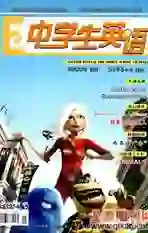ANIMALS
2009-03-16
本栏目特约主持人:
小强博士 男,2001年毕业于上海外国语大学,获文学博士学位;2007年赴英国访学,现任教于华中师范大学英语系。任教十余年来,始终对English teaching in secondary schools(中小学英语教学)抱有浓厚的兴趣;赴英国访学期间,更是通过实地参观、访问、旁听等方式详细了解了国外中小学英语教学的现状。希望借助《中学生英语》与全国的英语爱好者,尤其是青少年朋友们交流。
The Theme Diary 主题日志
“学而时习之,不亦乐乎”。有一种理解,就是要天天学而时时习,且要快乐地学,学有所成、学有所获。像《中学生英语》,你若走马观花,一口气看完,然后搁在一旁,多半难有收获。不如每天一刻钟,看上一两页,边看边想,学习心得随时记下来,日积月累,语言能力说不定就有了突破。这就是《中学生英语》增设The Theme Diary的初衷。从本期开始,我们会在页脚或纸头为大家提供记日志的地方。话不在多,在于精,大家只需三言两语,(最好是用英文)写下自己的学习心得或是每天的所思所想,也可摘录经典的英文片段。
今后杂志每期都为大家提供一个主题,附上与主题相关的地道的英文材料,材料里还有一些需要你亲自回答的问题或者亲手完成的小实验。对此感兴趣就先同老师和同学们探讨,然后把精彩的英文解答和设计寄给杂志社的小强博士,别忘了写上咒语——“蟑螂蟑螂在哪里(小强博士姓张哦)”;保证会有回信,上面还有暗语——“不爱老鼠爱大米”。同时欢迎大家把精彩的日志寄来。记住,对于上佳的答案、实验设计和日志,小强博士不会放进秘密档案封存,而是会登在《中学生英语》上,与全国的“蟑螂”爱好者们分享,届时还会回赠精美的礼品。
Live and Study Abroad 海外生活与学习
走出国门,曾经遥不可及,如今却并非白日做梦,毕竟我们在各种各样的场合接触到的“老外”是越来越多。我们要“迎进来”,也要“走出去”,外语学习的目的是要实现双向的而非单向的交流。《中学生英语》(七年级版)从本期起将为广大读者朋友提供第一手的海外生活与学习资料,帮助大家了解英美中学生衣食住行的现状。至少,看完下一期之后,碰到一个素不相识的外国小朋友冲上来对你说“I love you”,你既不会被吓坏,也不会狂喜不止,因为你既使暂时吃不到外国的猪肉,《中学生英语》也会告诉你外国的猪咋样跑。记住,Live and Study Abroad!
Mammals (哺乳动物)
Mammals are the worlds most dominant (最占优势的) animal. They are extremely (非常)diverse (多种多样的) creatures (生物,动物) that include (包括) the biggest ever animal (the blue whale (鲸), which eats up to 6 tons every day), the smallest (leaf-nosed bat) and the laziest (sloth, who spends 80% of their time sleeping). There are over 4,600 kinds of mammals and they live in very different environments(环境)—oceans (海洋), rivers, the jungle (丛林), deserts, and plains (平原).
哺乳类动物在地球上占据着统治地位,他们物种多样,包括体型最庞大的蓝鲸(每天进食多达6吨),体型最小的小蹄蝠和最懒惰的树獭(它一生中80%的时间在睡觉)。总共有4,600种哺乳类动物生活在海洋、河流、丛林、荒漠和平原等各种环境之中。
Birds (鸟)
Birds come in all shapes (形状) and sizes (大小), from the tiniest hummingbird(蜂鸟)(that can weigh as little as 2.2 grams), to the albatross (信天翁)(with a wing span of 3 meters or more). The common characteristic birds share is feathers(羽毛), but not all birds can fly. There are over 9,200 kinds of birds known around the world and they can be found in just about every habitat (栖息地). Although species (物种,种类) of animals and plants die out (灭绝) naturally, human activity threatens(威胁) to bring about the extinction (灭绝) of certain species in the coming decades (十年).
What can we do to safeguard (保卫,保护) the endangered animals?
鸟有大有小,形状各异,最小的蜂鸟体重仅有2.2克,而信天翁的翼展可达3米以上。鸟的共同特征是长有羽毛,但并非所有的鸟都会飞。全世界已知鸟的种类有9,200种,栖居在各种地方。尽管动植物物种会遭遇自然灭绝现象,但人类活动才是未来几十年里使物种灭绝的主要威胁。
我们应该怎样保护濒临危境的动物呢?
Insects (昆虫类)/Reptiles (爬行动物)/Amphibians (两栖类)
Insects, reptiles and amphibians often have a bad reputation(名声), but in fact they include some of the most fascinating (迷人的) creatures on the planet (行星). Insects make up (组成) the majority of living things and there are over a million different species while there are only 7,000 types(种类) of reptile. Reptiles have scales (鳞), breathe air and usually lay eggs. Amphibians live on both land and water. They are cold-blooded creatures(冷血动物) that use their environment to regulate (调节) their body temperature (体温).
昆虫、爬行动物和两栖类动物通常名声不佳,事实上它们中间有些却是这个星球上最迷人的动物。昆虫在地球动物中种类最多,计有100多万不同的种类;而爬行动物只有7,000多种。爬行动物长鳞,呼吸空气并且通常下蛋。两栖类动物在水下与陆地都可生存。它们都是冷血动物,会根据周围环境调节体温。
Sea Creatures (海洋生物)
The worlds oceans cover (覆盖) 71% of the earths surface (地球表面) and account for (占) 97% of the earths water. The deepest (最深的) point is the Mariana Trench, which is located in the Pacific Ocean (太平洋) and it is 11, 022 meters deep. The sea is warmed by the sun and the water temperature affects where different marine(海生的) life can live. Warm-blooded animals, like whales (鲸), and swim through varying (不同的) water temperatures. Other animals, such as starfish (海星) and tube worms (管虫), thrive at the bottom of the ocean and in deep trenches despite the low pressure and cold temperatures.
地球表面71%为海洋覆盖,那里蕴含地球上97%的水量。位于太平洋的马里亚纳海沟深11,022米,是最深的地方。海水的温度受太阳光照射的影响而变化,并因此影响生活在不同深度海洋生物的生活。热血动物如鲸鱼可以穿行于不同的水温层。其它一些动物如海星和管虫则无所谓低压与低温,在海底和海沟里大量繁衍。
Can you arrange (安排) a sports meeting for animals (e.g. sponsor a snail race)? 你能安排一场动物运动会吗(比方说发起蜗牛竞速赛)?
Sample Design (参考设计):
Snail Racing (蜗牛赛跑)
First of all, you need to find some snails. Look for snails with an aerodynamic shell(壳) and a competitive steak. Draw a circle(圆) on a large board (木板) that is 30 centimeters (厘米) in diameter(直径)—that will be the finish line(终点). In the middle of that circle draw a smaller one that will be the starting point (起点) for the race. Place (放) the snails inside the small circle and the first one to reach the outer (外面的) circle wins (赢)!
首先,找些蜗牛来,要找那些有着硬壳、体格健硕的。在一块大木板上画一个直径30厘米的圆——圆周就是终点。在圆心处画一个小圆作为竞赛的起点。将蜗牛放在小圆内,首先到达外围圆周的蜗牛为胜利者!
